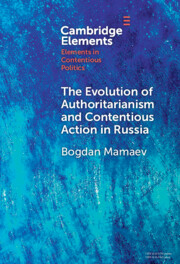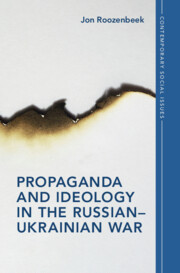558 results
4 - Foreign and Defence Policy
-
-
- Book:
- The Conservative Effect, 2010–2024
- Print publication:
- 27 June 2024, pp 102-130
-
- Chapter
- Export citation
5 - The Right World
-
- Book:
- World of the Right
- Print publication:
- 27 June 2024, pp 144-182
-
- Chapter
- Export citation

The Evolution of Authoritarianism and Contentious Action in Russia
-
- Published online:
- 30 May 2024
- Print publication:
- 20 June 2024
-
- Element
- Export citation
Imagining the future – rejecting the present: Future thought and defensive discourse strategies in Russian society during wartime
- Part of
-
- Journal:
- Memory, Mind & Media / Volume 3 / 2024
- Published online by Cambridge University Press:
- 23 May 2024, e14
-
- Article
-
- You have access
- Open access
- HTML
- Export citation
3 - Building a Propaganda Machine
-
- Book:
- Propaganda and Ideology in the Russian–Ukrainian War
- Published online:
- 16 May 2024
- Print publication:
- 23 May 2024, pp 49-64
-
- Chapter
- Export citation
2 - The Politics of the Donbas ‘Republics’
-
- Book:
- Propaganda and Ideology in the Russian–Ukrainian War
- Published online:
- 16 May 2024
- Print publication:
- 23 May 2024, pp 27-48
-
- Chapter
- Export citation
Introduction
-
- Book:
- Propaganda and Ideology in the Russian–Ukrainian War
- Published online:
- 16 May 2024
- Print publication:
- 23 May 2024, pp 1-6
-
- Chapter
- Export citation
6 - The Consequences of Propaganda
-
- Book:
- Propaganda and Ideology in the Russian–Ukrainian War
- Published online:
- 16 May 2024
- Print publication:
- 23 May 2024, pp 101-116
-
- Chapter
- Export citation
The Real-Time Impact of the War on Russian Imports: A Synthetic Control Method Approach
-
- Journal:
- World Trade Review , First View
- Published online by Cambridge University Press:
- 17 May 2024, pp. 1-15
-
- Article
-
- You have access
- HTML
- Export citation

Propaganda and Ideology in the Russian–Ukrainian War
-
- Published online:
- 16 May 2024
- Print publication:
- 23 May 2024
Great Power Competition, Clientelism, and De Facto States: Transnistria and Taiwan Compared
-
- Journal:
- Nationalities Papers , FirstView
- Published online by Cambridge University Press:
- 16 May 2024, pp. 1-22
-
- Article
-
- You have access
- Open access
- HTML
- Export citation
Long Live Article 2(4) of the UN Charter? Four Ways to Save the Peaceful Rules-Based International Order after Russia’s Invasion of Ukraine
-
- Journal:
- Nationalities Papers , FirstView
- Published online by Cambridge University Press:
- 14 May 2024, pp. 1-10
-
- Article
-
- You have access
- Open access
- HTML
- Export citation
Post-Soviet power hierarchies in the making: Postcolonialism in Tajikistan’s relations with Russia
-
- Journal:
- Review of International Studies , First View
- Published online by Cambridge University Press:
- 22 April 2024, pp. 1-21
-
- Article
-
- You have access
- Open access
- HTML
- Export citation
Assessment of the global population size of the Mongolian gazelle Procapra gutturosa
-
- Journal:
- Oryx , First View
- Published online by Cambridge University Press:
- 15 April 2024, pp. 1-10
-
- Article
-
- You have access
- Open access
- HTML
- Export citation
4 - The Effect of Foreign Policy on Climate and Energy Policy
-
- Book:
- Energy Transitions in Central and Eastern Europe
- Published online:
- 19 April 2024
- Print publication:
- 04 April 2024, pp 65-102
-
- Chapter
- Export citation
4 - Contractors and Hybrid Warfare
- from Part I - International Attribution
-
-
- Book:
- States, Firms, and Their Legal Fictions
- Published online:
- 29 February 2024
- Print publication:
- 07 March 2024, pp 69-86
-
- Chapter
- Export citation
4 - The Direct Line with Vladimir Putin
-
- Book:
- Dialogue with the Dictator
- Published online:
- 15 February 2024
- Print publication:
- 22 February 2024, pp 80-108
-
- Chapter
- Export citation
5 - Information Management, Performative Governance, and Image Making in the Direct Line
-
- Book:
- Dialogue with the Dictator
- Published online:
- 15 February 2024
- Print publication:
- 22 February 2024, pp 109-139
-
- Chapter
- Export citation
6 - The Carrot and the Stick
- from Part II - Three Case Studies
-
- Book:
- Rethinking Corruption
- Published online:
- 27 February 2024
- Print publication:
- 22 February 2024, pp 87-110
-
- Chapter
- Export citation
To Blockade or Not To Blockade? The Legal Status of Russia's Suspension of Shipping in the Sea of Azov
-
- Journal:
- Israel Law Review , First View
- Published online by Cambridge University Press:
- 22 February 2024, pp. 1-18
-
- Article
-
- You have access
- Open access
- HTML
- Export citation



